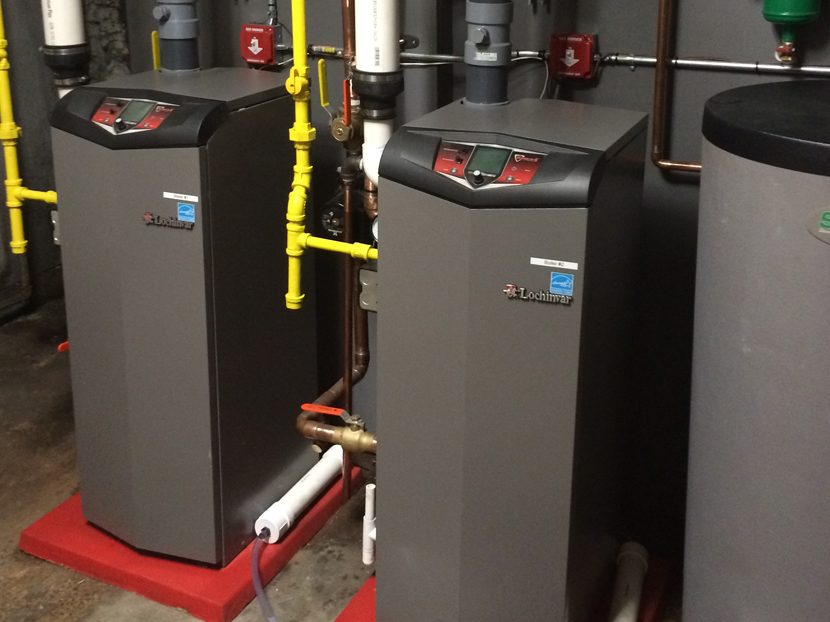'It’ll Never Work'
Converting an old church’s steam system to hot water involves patience — and math.

They warned me. They told me not to do it. They said I’m wasting my time and my customer’s money; they’ll never realize any energy savings. They said the radiators are going to leak because you’ll be operating at system pressures infinitely higher than the old system. They also said the new system would never provide enough heat because the output of the radiators will be so low.
Mr. and Mrs. Jones will be calling you in the dead of winter, at 1 a.m., because your fancy new system with all the bells and whistles isn’t able to heat their home as the old boiler did. Mrs. Jones won’t be happy and when she’s not happy, nobody’s happy. Mr. Jones will suggest you get in your truck right now, hightail it over there and make this thing right before she gives him the boot.
The “they” that I speak of are the most passionate hydronic installers and technicians in the country. They have arms like Goliath from swinging 3-foot and 4-foot steel pipe wrenches all day, hauling cast-iron boilers in and out of trucks and up and down stairs. They understand their systems better than anyone. They abide by Dan Holohan’s “The Lost Art of Steam Heating” as if it were etched on stone tablets by a power greater than themselves.
They have nicknames like Steamhead, Steamwright and Steam Whisperer. They are the Steam Boiler Experts. They know the potential pitfalls better than anyone. So, I heeded their warnings. I listened to them and even took notes. Then I went to work, keeping everything they taught me in mind.
From steam to hot water
The job I was asked to provide a bid for was at an old church, built in 1895, in Lemont, Illinois. Its steam boiler had failed, leaking from the sections like a sieve. There were more pipe repair clamps throughout the building than I’ve ever seen. On average, I’d estimate one clamp for every foot of pipe.
If the steam system were to remain, all the piping throughout the church would have to be replaced. It was obvious it had never been properly maintained or cared for, which is a shame because a properly set up steam system is a beautiful thing.
I based my design/bid on the fact I wanted to install an energy-efficient system that will keep the pastor and the congregants toasty warm all winter long without issue and without disrupting the building’s unparalleled integrity.
I planned to remove the steam boiler and all its piping — except the radiators, which I would convert to hot water — install two modulating condensing boilers, and run 2 1/2-inch PEX-Al-PEX pipe to each radiator and connect them to manifolds in the boiler room.
For a radiator to be converted from steam to hot water, it must be connected across the top and the bottom and four of them in this church were not. I was sure to make note of that and include new radiators in my proposal. Every steam guy out there probably wants to stop reading this article right about now. I challenge you not to.
Trust the math
At this point, I’m not certain my solution is viable. I must do the math and trust the math to make sure my design will perform up to, and beyond, expectations.
The first step is always a Manual J heat loss calculation to determine just how much heat the building is losing, and then compare it to the equivalent direct radiation (EDR) of the heat emitters throughout the church. The latter calculation will tell me how much heat each emitter is capable of delivering with both steam and hot water.
This is critical because steam is capable of 240 Btu/hour per square foot of radiation whereas hot water tops out at about 170 Btu/hour per square foot of radiation based on 180-degree water. When added all up, that 70 Btu/hour difference per square foot between steam and hot water is the key that makes or breaks the deal; it keeps them warm or lets them freeze.
The hardest part of doing a heat loss calculation is making sure you gather accurate information from the building. Inaccurate information being fed to load calculation software is going to spit out inaccurate numbers, resulting in improperly sized equipment.
Garbage in, garbage out, as the saying goes. Compounding errors is another way to look at it.
So, I spent the better part of the day measuring outside walls, windows, doors, insulation, building material, floor square footage, ceiling square footage and making some educated guesses based on what the church told me and what I know about construction after 38 years in the field. The envelope of this church would be considered loose at best — old windows, very little insulation, doors with air gaps, etc. The easiest part is the work back at the office where all I have to do is plug in the information and let the software do the heavy lifting.
The EDR calculation is something I still do by hand, but is just as effective. It starts with your list of radiators, their height and width, the number of columns or tubes and the total number of sections for the radiator. Table 1 shows the chart and the steps to calculate EDR.
Mod cons and efficiency
I’m encouraged by the results I’m getting. The total heat loss for the sanctuary and the meeting room below it came to 253,086 Btu/hour My connected load, or EDR, of all heat emitters came in 333,560 Btu/hour based on the aforementioned 180-degree water temperature.
I have significantly more radiation than needed to meet the heat loss. This means my hottest supply water temperature ever needed will be below 180 degrees. In any water heating system, the lower the return water temperature, the more efficient it is.
With modulating condensing boilers, there is no limit to how low we can go. For this system, we use a 20-degree design difference between the supply water and the return water temperature. It’s not an exact science, but it gives us a target.
Therefore, if we’re delivering 180-degree water to the radiators, we can expect 160-degree return water temperature under steady, stable conditions.
How efficient are we going to be? From Step 3 in Table 1, you’ll see we get 170 Btu/hour per square foot at 180-degree water temperature. Again, we have 333,560 Btu/hour, which is equivalent to 1,962 EDR. The math is so straightforward even I can get it. 333,560/170 = 1,962. Taking it one step further, take a look at Table 2. It gives us the Btu/hour per square foot and the corresponding supply water temperatures.
Here’s how it breaks down for the church:
SWT EDR x Btu/hr./ft.2 = Total Btu/hr.
160 F 1,962 x 130 = 255,060 Btu/hr.
150 F 1,962 x 110 = 215,820 Btu/hr.
140 F 1,962 x 90 = 176,580 Btu/hr.
130 F 1,962 x 70 = 137,340 Btu/hr.
120 F 1,962 x 50 = 98,100 Btu/hr.
110 F 1,962 x 30 = 58,860 Btu/hr.
100 F 1,962 x 10 = 19,620 Btu/hr.
As you see, we will be able to heat the church with 160-degree supply water temperature on the coldest day of the year because the heat loss is only a little more than 253,000 Btu/hr. It will give us 140-degree return water temperature, which is very close to the flue gas-condensing mode of 135 degree.
This is playing out about as well as I could have hoped for. It’s only the coldest day of the year for one day so these boilers, properly sized, are going to be in condensing mode much of the season.
That’s exactly what you want from a mod-con boiler. If we weren’t going to be in condensing mode most of the time, I would have suggested sticking with steam. But now I know with absolute certainty that the operating efficiency of the boilers will be significantly higher than a steam boiler.
It gets even better. The equipment I proposed was two floor-standing boilers with 10:1 modulation turndown ratios. Paired and cascaded, the turndown could be as high as 20:1. Steam boilers can’t do that.
Based on my design, the detailed presentation I gave the church council and the fact that we hit it off, I was awarded the job. That was two years ago. Everything has gone well for the first two winters. There were some adjustments needed for the outdoor reset control until we hit the sweet spot for the congregants’ comfort level, but that is to be expected on most jobs. I also had to persuade them to remove the radiator covers, which cut down on the heat output significantly.
I pressure-tested each radiator at 25 psi before connecting them to the new home-run manifold distribution system. We had two leakers right off the bat and none since then. I consider it a win. I forewarned the church staff that we may have a few radiators to be replaced. While we pressure-tested them, we also flushed each one, removing all the rust and debris from the remainder of the steam system. Drilling and tapping each radiator for the manual coin vent went smooth as silk.
We had a drop ceiling on the lower level where my guys were able to neatly and quickly run the new PAP supply and return lines to each radiator. The manifolds in the boiler room had flow meters and valves for adjusting, so we were able to dial in the flow to each radiator based on its size.
It’s rare that these conversions make sense, but I had a feeling the first day I looked at the system that this might be one of them. I did the math and trusted the math. They, the steam guys, taught me everything I needed to know to avoid the mistakes that can and do happen. All this would not have been possible without them giving me a game plan. Thank you! l
Stephen Minnich has nearly 40 years of experience in the heating industry, primarily installing and servicing hydronic systems. He most recently operated Minnich Mechanical Design, based in the Chicago suburb of Elk Grove Village. Minnich is currently an HVAC consultant for Elevate Energy, Chicago.





